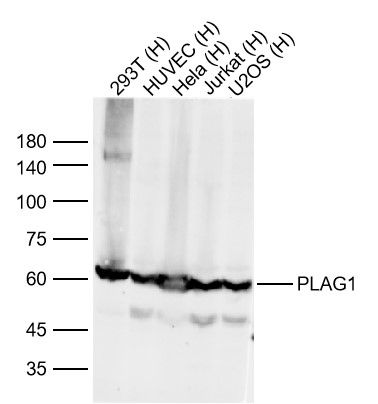
Rabbit Anti-PLAG1 antibody
FGFR1/PLAG1 fusion variant 3; Pleiomorphic adenoma gene 1 protein; PSA; SGPA; COL1A2/PLAG1 fusion; Plag1; PLAG1_HUMAN; Pleiomorphic adenoma gene 1; Zinc finger protein PLAG1; ZNF912.
View History [Clear]
Details
Product Name PLAG1 Chinese Name 多型性腺瘤基因1蛋白抗体 Alias FGFR1/PLAG1 fusion variant 3; Pleiomorphic adenoma gene 1 protein; PSA; SGPA; COL1A2/PLAG1 fusion; Plag1; PLAG1_HUMAN; Pleiomorphic adenoma gene 1; Zinc finger protein PLAG1; ZNF912. Research Area Tumour Cell biology Signal transduction transcriptional regulatory factor Immunogen Species Rabbit Clonality Polyclonal React Species Human, Mouse, (predicted: Rat, Dog, Pig, Cow, Horse, Rabbit, ) Applications WB=1:500-2000 ELISA=1:5000-10000
not yet tested in other applications.
optimal dilutions/concentrations should be determined by the end user.Theoretical molecular weight 56kDa Cellular localization The nucleus Form Liquid Concentration 1mg/ml immunogen KLH conjugated synthetic peptide derived from human PLAG1: 51-150/500 Lsotype IgG Purification affinity purified by Protein A Buffer Solution 0.01M TBS(pH7.4) with 1% BSA, 0.03% Proclin300 and 50% Glycerol. Storage Shipped at 4℃. Store at -20 °C for one year. Avoid repeated freeze/thaw cycles. Attention This product as supplied is intended for research use only, not for use in human, therapeutic or diagnostic applications. PubMed PubMed Product Detail Pleomorphic adenoma gene 1 encodes a zinc finger protein with 2 putative nuclear localization signals. PLAG1, which is developmentally regulated, has been shown to be consistently rearranged in pleomorphic adenomas of the salivary glands. PLAG1 is activated by the reciprocal chromosomal translocations involving 8q12 in a subset of salivary gland pleomorphic adenomas. Three transcript variants encoding two different isoforms have been found for this gene. [provided by RefSeq, Jul 2008]
Function:
Transcription factor whose activation results in up-regulation of target genes, such as IGFII, leading to uncontrolled cell proliferation: when overexpressed in cultured cells, higher proliferation rate and transformation are observed. Other target genes such as CRLF1, CRABP2, CRIP2, PIGF are strongly induced in cells with PLAG1 induction. Proto-oncogene whose ectopic expression can trigger the development of pleomorphic adenomas of the salivary gland and lipoblastomas. Overexpression is associated with up-regulation of IGFII, is frequently observed in hepatoblastoma, common primary liver tumor in childhood. Cooperates with CBFB-MYH11, a fusion gene important for myeloid leukemia.
Subunit:
Interacts with KPNA2, which escorts protein to the nucleus via interaction with nuclear localization signal. Interacts with E3 SUMO-protein ligase PIAS1, PIAS2 and PIAS4.
Subcellular Location:
Nucleus. Strong nucleolar localization when sumoylation is inhibited.
Tissue Specificity:
Expressed in fetal tissues such as lung, liver and kidney. Not detected or weak detection in normal adult tissues, but highly expressed in salivary gland with benign or malignant pleiomorphic adenomas with or without 8q12 abberations, with preferential occurrence in benign tumors.
Post-translational modifications:
Sumoylated by SUMO1; which inhibits transcriptional activity, but does not affect nuclear localization. Blockers of sumoylation pathway such as SENP3 and inactive UBE2I increases transcriptional capacity. Sumoylation is increased in the presence of PIAS1.
Acetylated by lysine acetyltransferase EP300; which activates transcriptional capacity. Lysine residues that are sumoylated also seem to be target for acetylation.
DISEASE:
Note=A chromosomal aberration involving PLAG1 is found in salivary gland pleiomorphic adenomas, the most common benign epithelial tumors of the salivary gland. Translocation t(3;8)(p21;q12) with constituvely expressed beta-catenin/CTNNB1. Fusion occurs in the 5'-regulatory regions, leading to promoter swapping between the 2 genes and activation of PLAG1 expression in adenomas. The chimeric transcript is formed by fusion of CTNNB1 exon 1 to PLAG1 exon 3. Reciprocal fusion transcript consisting of PLAG1 exon 1 and CTNNB1 exon 2-16 is also revealed in some adenomas. Translocation t(3;8)(p21;q12) with transcription elongation factor SII/TCEA1. The fusion transcript is composed of 5'-non-coding sequences as well as 63 nucleotides of the coding region of TCEA1 fused to the acceptor splice site of PLAG1 exon 3. The fusion transcript encodes a truncated TCEA1-PLAG1 protein of 90 AA as well as an apparently normal PLAG1 protein. Reciprocal fusion transcript PLAG1-TCEA1 is also present in one adenoma. Translocation t(5;8)(p13;q12) with leukemia inhibitory factor receptor LIFR. This fusion occured in the 5'-non-coding sequences of both genes, exchanging regulatory control element while preserving the coding sequences. Translocation t(6;8)(p21.3-22;q13) with Coiled-coil-helix-coiled-coil-helix domain-containing protein 7/CHCHD7. Fusion occurs in the 5' regulatory regions, leading to promoter swapping and up-regulation of PLAG1 expression. Ectopic expression of PLAG1 under the control of promoters of distinct translocation partner genes is a general pathogenetic mechanism for pleiomorphic adenomas with 8q aberrations. These fusion genes are likely to be found in adenomas with normal karyotype as this subgroup of tumors also exhibit PLAG1 activation.
Note=A chromosomal aberration involving PLAG1 may be a cause of lipoblastomas, which are benign tumors resulting from transformation of adipocytes, usually diagnosed in children. 8q12.1 to 8q24.1 intrachromosomal rearrangement with hyaluronic acid synthase 2/HAS2 results in promoter swapping and activation of PLAG1 expression. The breakpoint of HAS2 gene is in PLAG1 intron 1, whereas its coding sequence starts at exon 2 or exon 3. Translocation t(7;8)(p22;q13) with collagen 1A2/COL1A2. Fusion transcript COL1A2-PLAG1 as well as HAS2-PLAG1 encode a full-length PLAG1 protein.
Similarity:
Belongs to the krueppel C2H2-type zinc-finger protein family.
Contains 7 C2H2-type zinc fingers.
SWISS:
Q6DJT9
Gene ID:
5324
Database links:Entrez Gene: 5324 Human
Entrez Gene: 56711 Mouse
Omim: 603026 Human
SwissProt: Q6DJT9 Human
SwissProt: Q9QYE0 Mouse
Unigene: 14968 Human
Unigene: 331467 Mouse
Unigene: 39161 Rat
Product Picture
Lane 1: Human 293T cell Lysates
Lane 2: Human HUVEC cell Lysates
Lane 3: Human Hela cell Lysates
Lane 4: Human Jurkat cell Lysates
Lane 5: Human U2OS cell Lysates
Primary: Anti-PLAG1 (SL10092R) at 1/1000 dilution
Secondary: IRDye800CW Goat Anti-Rabbit IgG at 1/20000 dilution
Predicted band size: 56kDa
Observed band size: 56kDa
Bought notes(bought amounts latest0)
No one bought this product
User Comment(Total0User Comment Num)
- No comment



 +86 571 56623320
+86 571 56623320
 +86 18668110335
+86 18668110335

